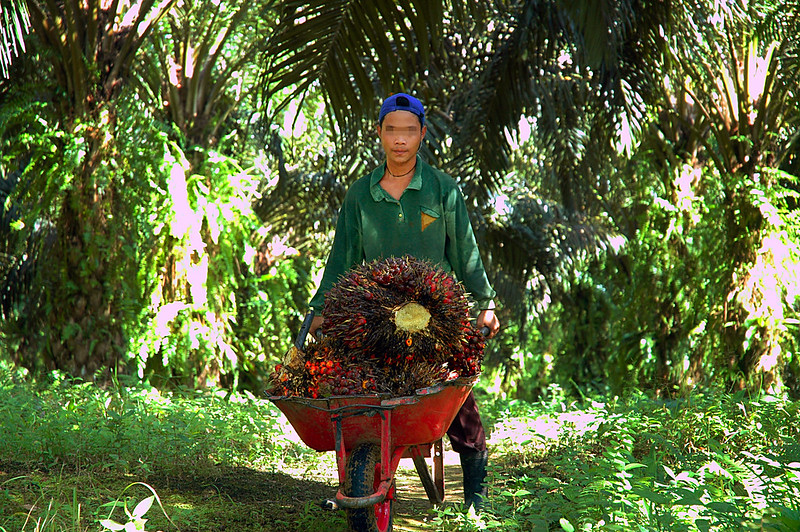
A summary for teachers and educators with key ideas, debates and activities relating to the chocolate industry, ethical food production such as Fairtrade and the ongoing realities of child labour in the cocoa trade, by Colm Regan
Chocolate is everywhere – in our homes, in shops, cafes, on television, in advertising and it is frequently associated with special occasions such as festivals and birthdays; it is increasingly considered to be a celebration food all around the world.
In this context, it is no surprise to learn that the average Irish person consumes about 8 kilos of it each year placing Ireland in the top ranks of chocolate consumers worldwide just behind Switzerland, Austria and Germany. On average we each spent over €140 on chocolate in 2017. Europeans consume nearly half of all the chocolate the world eats.
Chocolate consumption hasn’t traditionally been as popular in other parts of the world with, for example an average Indian consuming just 165 grams and the average Chinese person just 99 grams but that situation is rapidly changing and Asian demand is expected to reach a 20% share by 2020.
Most of us base our decisions around buying cocoa and chocolate products mostly on taste, on the brand name we like most, on quality and, of course price. Sometimes we even check out the list of ingredients to, for example avoid dairy products or to seek a higher cacao or lower sugar content. In recent times, many of us look for important labels like Fairtrade or organic or vegan.
But many people are also interested (or should be interested) in finding out if slave or child labour was used in making their chocolate product as most would be unhappy if this was the case. Few of us would want our desire for chocolate to be at the expense of others, especially children. As a result, there have been many studies that have researched the issue and below we present the key findings of those studies.
Finding out how ethical your chocolate is not as difficult as you might think.
Chocolate can also have a dark side
- 1.8 million children are estimated to be at risk of working under the worst forms of Child Labour conditions as outlined by the UN
- 9 million of the estimated 27 million slaves in the world today are children
- Children are being trafficked everyday to work on cocoa farms as slaves and the average cost for a child is US$250
Chocolate companies have promised for many years to change this situation, but yet it continues today.
Some quick facts about cocoa and child labour
Cocoa and chocolate production have been in the news in recent years particularly linked to human rights and environmental issues.
- There are about 5 to 6 million cocoa farmers around the world
- Between 40 to 50 million people depend on cocoa for the living
- The world’s cocoa growing regions include Africa, Asia, Central America, South America – all are within 20 degrees of the equator
- 70% of all cocoa comes from West Africa
- Chocolate is an $83 billion a year business making it larger than the GDP of more than 130 countries around the world.
Being better informed on these issues helps us to understand the chocolate choices we make (as well as those we don’t make) and to fully appreciate the range of choices that we have and the tradeoffs associated with our choices. It also helps us recognise the alternatives we have available if we are not happy about the conditions in which our favourite chocolate product is produced.
Child labour and chocolate
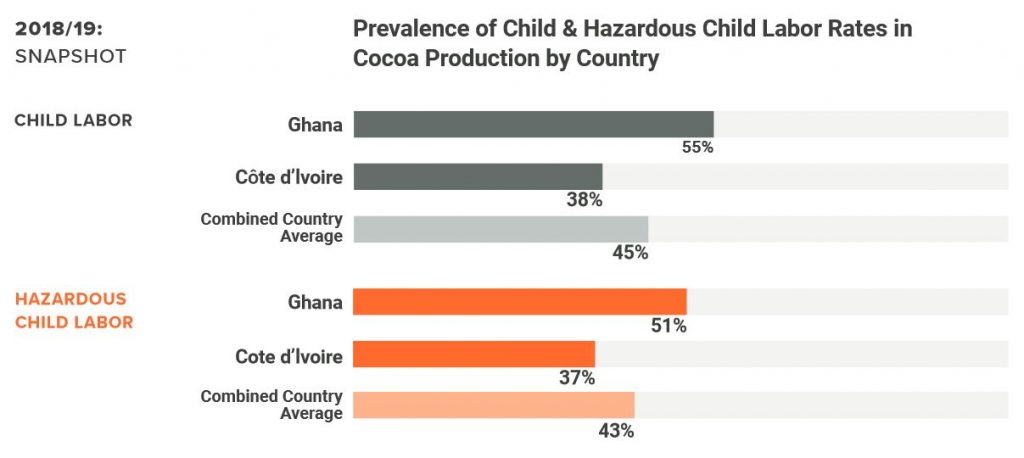
Recent reports have again confirmed that child labour and even child slavery are common practices on West African cocoa farms, where 75% of the world’s cocoa is produced. Children on cacao farms face long workdays as well as using heavy and potentially dangerous tools to harvest cacao pods.
Significant quantities of cocoa are also grown in Latin America, including most of the world’s organic cocoa. Although child and/or slave labour have not been documented in Latin America, there is also concern about its possible use.
Research published in late 2020 by the NORC research institute at the University of Chicago found that:
- 43% of all children aged between 5 and 17 in cocoa-growing regions of Ghana and Ivory Coast – the world’s largest cocoa producers – are engaged in hazardous work.
- In total, an estimated 1.56 million children work in cocoa production in these two west African nations alone.
- Hazardous work includes the use of sharp tools, working at night and exposure to agrochemical products, among other harmful activities.
- The report notes that the overall proportion of children working has gone up by 14% in the past decade.
The increase is accompanied by a 62% rise in production over the same period. This has led to harsh criticism of chocolate makers who have promised time and time again to resolve the issue. Despite missing deadlines to deliver on this promise in 2005, 2008 and 2010, the companies continue to insist that ending the illegal practice remains their top concern.
Check out the NORC report Assessing Progress in Reducing Child Labor in Cocoa Production in Cocoa Growing Areas of Côte d’Ivoire and Ghana:
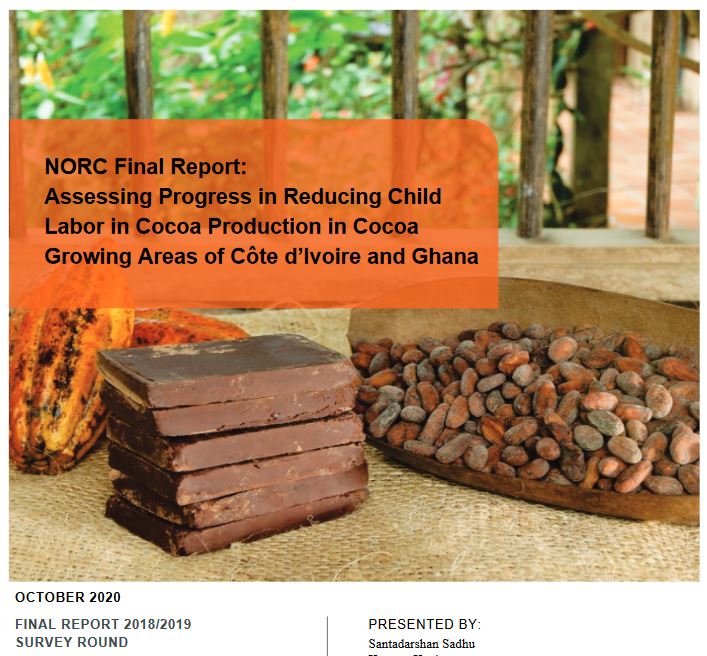
Unfortunately, there is still no way to be 100% certain that the chocolate we buy has been made without the use of child labour or child slavery. The Fairtrade labeling process and Rainforest Alliance/UTZ are a great start but are not perfect; they are faced by the same challenges as other certification schemes which can’t yet guarantee that cocoa products are made without the use of exploitative labour in West Africa, despite these schemes prohibiting child labour.
For more on this, see:
- Tony’s Chocoloney – a case study of what one company does and how it tackles modern day slavery in its supply chain
- 12 Fairtrade chocolate choices you can make in your shop – a blog by Fairtrade Ireland
- Read more about child slavery and working conditions as well as information about consumer challenges around such labour at the Food Empowerment Project.
- Make Chocolate Fair – a European campaign that mobilizes Europeans to become active towards more justice in the global cocoa industry
Chocolate’s ingredients
Aside from milk the main ingredient in many chocolate products is palm oil, a product that also has major ethical implications. The production of palm oil has implications for deforestation as well as for the world’s orangutan population.
Awareness on these issues is increasing with awareness raising, research and reports, media coverage and campaigning. For more information about palm oil, and how you can get involved, check out our in-depth look at the issue: Are You Eating Dirty Oil?
In the meantime, the safest bet is to choose chocolate bars and chocolate-containing products that do not contain palm oil. You can follow up on the issue here Vegan Products and Palm Oil.
Making chocolate
Chocolate is now so universal we tend not to think of it as exotic but the reality is very different. Key inputs for most chocolate products have usually traveled extensively around the globe. Nearly all cacao is grown in West Africa or Latin America, and ingredients such as vanilla and cane sugar are also grown in distant locations such as Madagascar, Indonesia, South America, and Thailand.
It is currently estimated that Western Europe accounts for approximately 35% of total world chocolate production with the U.S. accounting for an additional 30%. As a result of history and current trade structures and patterns none of the major producers of chocolate are major sources of cocoa and none of the major cocoa-producing countries are major chocolate manufacturing locations.
Consuming chocolate certainly won’t make our carbon footprint any smaller, so we need to consider the environmental impacts of that reality also.
Reasons why child labour is a problem
Child labour is any work done by a child that may be harmful to their physical, emotional, intellectual and social development
UN Convention on the Rights of the Child
Child labour has long been a major challenge for many countries especially for countries in the global south. So much so that countries have introduced laws to prohibit such labour, most especially in its worst forms.
Why is it a problem?
- Because it denies children their most basic rights – protection and freedom from exploitation
- Because it means children are at work instead of going to school. Children are denied their right to full-time quality education which is the key to escaping poverty. By working instead of learning, the cycle of poverty is perpetuated
- Because young children around the world are involved in dangerous and physically damaging work
- Because it makes it difficult for adults to find employment when employing children is cheaper. Child labour excludes adults from the work force and this creates poverty.
Is all child labour harmful?
No!
But let’s be clear: child labour is any labour that prevents a child from receiving a full time formal education. Helping around the house or farm or working in a local shop on weekends or for a few hours after school during the week is not child labour. In fact, this kind of work can be good for a young person – it helps them learn valuable life skills.
However, if this work prevents a child from receiving a full-time formal education and when it contravenes existing laws on the minimum age and conditions for employment, it becomes child labour.
How does such labour harm children?
- It causes serious damage to children’s health as a result of violence, injury or disease
- It impinges on the social, emotional and moral development of children
- It leads to the exploitation of children through force, low wages, poor working conditions and sexual/psychological abuse
- It contributes to continuing poverty for individuals, families and whole communities
- It is a denial of the basic rights of millions of children
- It denies the right to education, health, leisure time and human development for many of the world’s poorest and most vulnerable children
In effect, child labour implies that childhood is lost – young children are forced too early to think and act and work like adults. The long-term impact of this reality can be severe health-wise, emotionally as well as physically; young children forced to work at an early age are placed at considerable disadvantage to other children.
5 chocolate and child labour activities
- Begin the discussion by asking why is child labour a problem? What are its consequences and what do we think about them? Then compare and contrast the answers and discussion with what is presented above.
- Undertake a chocolate audit of your home – how much do you consume, what products, how much is this per year, what do other family members think about the ethics of chocolate etc.?
- Use a set of chocolate product labels to check out the information on the issues discussed above – what is included, what is left out? What do you conclude from this?
- Have a look at one of the websites listed above and then write a review of it – how did your respond to the information and argument offered? Has it changed any of your views?
- Check out the Cadbury’s site – https://www.cadbury.co.uk/cocoa-life and the sections on child labour, women’s empowerment and climate change and then compare it with the arguments offered on https://makechocolatefair.org/campaign
For more
- A key teaching resource on child labour issues from Concern Worldwide – context, history, definition, the legal situation, myths, poverty, business and responsibility, country and product case studies, the consumer and child labour, campaigns etc.
- Top 10 facts about the Fairtrade movement in Ireland, by Tony Daly
- Does child labour exist in rich countries? Is all work for children considered harmful? Here are five often repeated myths about child labour from the Guardian newspaper
- Debating Fairtrade – an extended debate piece of the key arguments by Colm Regan
More detail and debate here:
- Stop Child Labour campaign website
- Anti-Slavery International child slavery update
- UNICEF overview of child labour and programmes seeking to combat it
- International Labour Organisation overview of child labour and video.
- Tagged as Child Labour, Children's Rights, Chocolate, Cocoa, Fairtrade
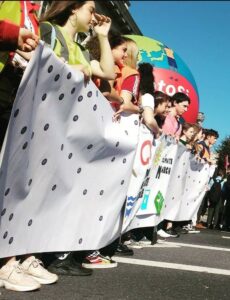
Calling Post Primary Teachers – Survey Participation Request
Your voice is vital in shaping the future of education for sustainable development in Ireland. Join a national survey for post primary teachers in October, led by DCU researcher Valerie Lewis

Webinar: Science for development on World Food Day
The webinar will feature YSTE projects, from Santa Sabina Dominican College (Dublin), Moate Community School (Westmeath) and CBS Thurles that focussed on nutrition and better food production, with Self Help Africa’s nutrition and gender specialist in Ethiopia, Sara Demissew.
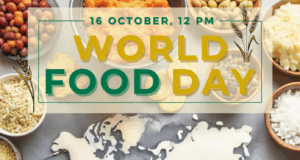
Student & teacher webinar: Food, hunger and SDG 2
Join the World Food Day webinar for post primary school students and teachers which will explore SDG 2, hunger in today’s world and how you can make a difference locally and globally.

Beth Doherty: Youth Activism and the Climate Crisis
From School Strikes to Global Climate Talks The latest episode of the Irish Global Solidarity in 100 Objects podcast features Beth Doherty, climate activist and

Mary Lawlor: Defending Human Rights Defenders
A Conversation with the UN Special Rapporteur for Human Rights Defenders The latest episode of the Irish Global Solidarity in 100 Objects podcast features Mary
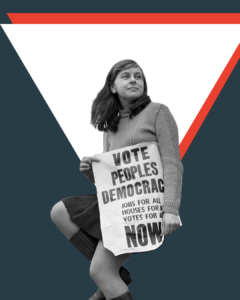
Irish Women in Activism and Advocacy
Explore inspiring stories of Irish women in activism and advocacy who have fought for human rights, social justice, and equality at home and abroad
